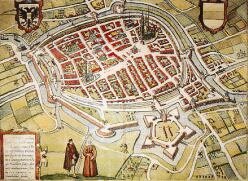Textiles found in moat of former fort in Groningen

6 March - 30 August 2009
Recent archeological excavations cast a light on the way people in Groningen dressed during the sixteenth century. The University of Groningen now displays the story of these textiles.
In 1568, in order to prevent an attack of the city of Groningen by the armies of the Prince of Orange, the Spanish Duke of Alba, governor of the Habsburg Netherlands, ordered the construction of a fort on the southern edge of the town. The groundwork got under way with some difficulty and was halted for a considerable period. In 1575 the work was resumed, and the two northernmost bastions were built. The townsfolk were opposed to the project from the start, because they had to pay and to build the fort themselves. When in 1577 they got permission to dismantle the fort, the town's ramparts were restored and the two northernmost points together with part of the moat ended up within the city. For the following twenty years, this moat served as a landfill for the town's waste, until from 1594 on, it was finally filled in.
There is an abundance of textile finds from excavations of 2000 in the southern part of the city centre of the town. The significance of the finds lies not only in their large quantity and diversity, but also in the fact that they come from a feature that was open for 20 years at the most. However, the moat's dating tells us only about the end of the textiles' use life. Within the social and economic context of the 16th century, one may assume that for textiles a long time, half a century or even more, may have passed between their first use and the dumping of the last rag.

